New and Sustainable Coal Char-Based Paving Blocks for Roadway Applications
Abstract
:1. Introduction
2. Materials Properties, Mix Design, and Method of Manufacturing
2.1. Material Properties
2.2. Mix Design and Method of Manufacturing
3. Testing Methods and ASTM Requirements
4. Engineering Properties and Comparison with Commercial Paving Blocks
4.1. Bulk Density
4.2. Compressive Strength
4.3. Abrasion Resistance
4.4. Water Absorption
4.5. Freeze-Thaw Durability
5. Results and Discussion
6. Conclusions
7. Patents
Author Contributions
Funding
Data Availability Statement
Conflicts of Interest
References
- Al-Kheetan, M.J. Properties of Lightweight Pedestrian Paving Blocks Incorporating Wheat Straw: Micro-to Macro-Scale Investigation. Results Eng. 2022, 16, 100758. [Google Scholar] [CrossRef]
- ASTM C1272-22A; Standard Specification for Heavy Vehicular Paving Brick. ASTM: West Conshohocken, PA, USA, 2023.
- Michael, L.; Abate, K. Concrete Paving Blocks: An Overview; Washington State Department of Transportation: Seattle, WA, USA, 1993.
- Namarak, C.; Bumrungsri, C.; Tangchirapat, W.; Jaturapitakkul, C. Development of Concrete Paving Blocks Prepared from Waste Materials without Portland Cement. Mater. Sci. 2018, 24, 92–99. [Google Scholar] [CrossRef]
- Mampearachchi, W. Handbook on Concrete Block Paving, 1st ed.; Springer: Berlin/Heidelberg, Germany, 2019. [Google Scholar]
- Interlocking Concrete Pavers Market Size, Share, Competitive Landscape and Trend Analysis Report by Thickness, by Application, by End-User: Global Opportunity Analysis and Industry Forecast, 2023–2032. Available online: https://www.alliedmarketresearch.com/interlocking-concrete-pavers-market-A131494 (accessed on 8 April 2024).
- Mohamad, N.; Muthusamy, K.; Embong, R.; Kusbiantoro, A.; Hashim, M.H. Environmental Impact of Cement Production and Solutions: A Review. Mater. Today Proc. 2022, 48, 741–746. [Google Scholar] [CrossRef]
- Ohunakin, O.S.; Leramo, O.R.; Abidakun, O.A.; Odunfa, M.K.; Bafuwa, O.B. Energy and Cost Analysis of Cement Production Using the Wet and Dry Processes in Nigeria. Energy Power Eng. 2013, 05, 537–550. [Google Scholar] [CrossRef]
- He, Z.; Shen, A.; Lyu, Z.; Li, Y.; Wu, H.; Wang, W. Effect of Wollastonite Microfibers as Cement Replacement on the Properties of Cementitious Composites: A Review. Constr. Build. Mater. 2020, 261, 119920. [Google Scholar] [CrossRef]
- Ahmad, J.; Kontoleon, K.J.; Majdi, A.; Naqash, M.T.; Deifalla, A.F.; Ben Kahla, N.; Isleem, H.F.; Qaidi, S.M.A. A Comprehensive Review on the Ground Granulated Blast Furnace Slag (GGBS) in Concrete Production. Sustainability 2022, 14, 8783. [Google Scholar] [CrossRef]
- Nayak, D.K.; Abhilash, P.P.; Singh, R.; Kumar, R.; Kumar, V. Fly Ash for Sustainable Construction: A Review of Fly Ash Concrete and Its Beneficial Use Case Studies. Clean. Mater. 2022, 6, 100143. [Google Scholar] [CrossRef]
- Chen, X.; Sun, Z.; Pang, J. Study on Metakaolin Impact on Concrete Performance of Resisting Complex Ions Corrosion. Front. Mater. 2021, 8, 788079. [Google Scholar]
- Rodríguez-Camacho, R.E.; Uribe-Afif, R. Importance of Using the Natural Pozzolans on Concrete Durability. Cem. Concr. Res. 2002, 32, 1851–1858. [Google Scholar] [CrossRef]
- Çullu, M.; Bolat, H.; Vural, A.; Tuncer, E. Investigation of Pozzolanic Activity of Volcanic Rocks from the Northeast of the Black Sea. Sci. Eng. Compos. Mater. 2016, 23, 315–323. [Google Scholar] [CrossRef]
- Ghasemi, A.; Soleimani Amiri, S.; Habibnejad Korayem, A.; Mirvalad, S. Investigating the Potential of Trass-Cement Binary Blend for Enhancing Microscopic Properties, Macroscopic Performance, and Sustainability of Cement Paste. Constr. Build. Mater. 2022, 354, 129145. [Google Scholar] [CrossRef]
- De Bortoli, A. Understanding the Environmental Impacts of Virgin Aggregates: Critical Literature Review and Primary Comprehensive Life Cycle Assessments. J. Clean. Prod. 2023, 415, 137629. [Google Scholar] [CrossRef]
- San Vicente-Navarro, A.; Mendívil-Giro, M.; Los Santos-Ortega, J.; Fraile-García, E.; Ferreiro-Cabello, J. Alternative Use of the Waste from Ground Olive Stones in Doping Mortar Bricks for Sustainable Façades. Buildings 2023, 13, 2992. [Google Scholar] [CrossRef]
- Zegardło, B. Comparative Assessment of Environmental Effects by LCA Method of Natural Aggregates Extraction Processes and Production of Their Substitutes from Waste in the City Mining System. J. Ecol. Eng. 2021, 22, 251–257. [Google Scholar] [CrossRef] [PubMed]
- Gawenda, T. Production Methods for Regular Aggregates and Innovative Developments in Poland. Minerals 2021, 11, 1429. [Google Scholar] [CrossRef]
- Perera, F. Pollution from Fossil-Fuel Combustion Is the Leading Environmental Threat to Global Pediatric Health and Equity: Solutions Exist. Int. J. Env. Res. Public Health 2017, 15, 16. [Google Scholar] [CrossRef] [PubMed]
- Guo, P.; Wang, Q.; Liu, J.; Wang, T.; Zhao, J.; Wu, D. Mechanical Behavior of Compression-Compacted Dry Concrete Paver Blocks Making Use of Sea Sand and Seawater. Buildings 2023, 13, 2979. [Google Scholar] [CrossRef]
- Euniza, J.; Hasanan, M.N.; Ramadhansyah, P.J.; Zaiton, H. Use of Waste Tyre Rubber as Aggregate in Double Layer Concrete Paving Blocks. J. Adv. Res. App. Mech. 2014, 1, 25–30. [Google Scholar]
- Nandi, S.; Ransinchung, G.D.R.N. Performance Evaluation and Sustainability Assessment of Precast Concrete Paver Blocks Containing Coarse and Fine RAP Fractions: A Comprehensive Comparative Study. Constr. Build. Mater. 2021, 300, 124042. [Google Scholar] [CrossRef]
- Kundu, S.P.; Chakraborty, S.; Chakraborty, S. Effectiveness of the Surface Modified Jute Fibre as Fibre Reinforcement in Controlling the Physical and Mechanical Properties of Concrete Paver Blocks. Constr. Build. Mater. 2018, 191, 554–563. [Google Scholar] [CrossRef]
- Zhang, R.; Liu, D.; Wang, Q.; Luo, Z.; Fang, M.; Cen, K. Coal Char Gasification on a Circulating Fluidized Bed for Hydrogen Generation: Experiments and Simulation. Energy Technol. 2015, 3, 1059–1067. [Google Scholar] [CrossRef]
- Owusu, P.A.; Asumadu-Sarkodie, S. A Review of Renewable Energy Sources, Sustainability Issues and Climate Change Mitigation. Cogent Eng. 2016, 3, 1167990. [Google Scholar] [CrossRef]
- Gasparotto, J.; Da Boit Martinello, K. Coal as an Energy Source and Its Impacts on Human Health. Energy Geosci. 2021, 2, 113–120. [Google Scholar] [CrossRef]
- Yu, H.; Joshi, P.; Lau, C.; Ng, K. Novel Application of Sustainable Coal-Derived Char in Cement Soil Stabilization. Constr. Build. Mater. 2024, 414, 134960. [Google Scholar] [CrossRef]
- Yu, H.; Jonchhe, P.; Lau, C.; Ng, K. Temperature Effect on Density, Strength, and Microstructure of Sustainable Coal Char-Cement Grout. J. Build. Eng. 2023, 80, 107975. [Google Scholar] [CrossRef]
- Hossain, M.T.; Lau, C.; Yu, H.; Ng, K. Development of Coal-Derived Carbon-Based Structural Unit as a Potential New Building Material. J. Mater. Sci. 2023, 58, 757–772. [Google Scholar] [CrossRef]
- Olayiwola, S.O.; Ng, K. Influence of Fly-Ash Reaction on the Performance of Coal-Derived Char Bricks. J. Mater. Civ. Eng. 2023, 35, 04023337. [Google Scholar] [CrossRef]
- Yu, H.; Kharel, S.; Lau, C.; Ng, K. Development of High-Strength and Durable Coal Char-Based Building Bricks. J. Build. Eng. 2023, 74, 106908. [Google Scholar] [CrossRef]
- Pandey, S.P.; Yu, H.; Lau, C.; Ng, K. New Coal Char-Based Building Products: Manufacturing, Engineering Performance, and Techno-Economic Analysis for the USA Market. Sustainability 2024, 16, 1854. [Google Scholar] [CrossRef]
- ASTM C936/C936M-23a; Standard Specification for Solid Concrete Interlocking Paving Units. ASTM: West Conshohocken, PA, USA, 2023.
- ASTM C418-20; Standard Test Method for Abrasion Resistance of Concrete by Sandblasting. ASTM: West Conshohocken, PA, USA, 2023.
- ASTM C140/140M-23a; Standard Test Methods for Sampling and Testing Concrete Masonry Units and Related Units. ASTM: West Conshohocken, PA, USA, 2023.
- ASTM C1645-22a; Standard Test Method for Freeze-Thaw and De-Icing Salt Durability of Solid Concrete Interlocking Paving Units. ASTM: West Conshohocken, PA, USA, 2022.
- Density of Cement, Portland (Material). Available online: https://www.aqua-calc.com/page/density-table/substance/cement-coma-and-blank-portland (accessed on 27 January 2024).
- 31200—Trass Powder. Available online: https://shop.kremerpigments.com/elements/resources/products/files/31200_SHD_ENG.pdf (accessed on 14 January 2024).
- Trass Lime 2.0. Available online: https://www.otterbeinusa.com/products/trass-lime-2-0 (accessed on 21 January 2024).
- Mission Tumbled 8 in. × 4 in. × 2.25 in. Clay Red Paver. Available online: https://www.homedepot.com/p/Mission-Tumbled-8-in-x-4-in-x-2-25-in-Clay-Red-Paver-030734004/204297542 (accessed on 25 August 2023).
- Di Mascio, P.; Moretti, L.; Capannolo, A. Concrete Block Pavements in Urban and Local Roads: Analysis of Stress-Strain Condition and Proposal for a Catalogue. J. Traffic Transp. Eng. 2019, 6, 557–566. [Google Scholar] [CrossRef]
- Ghareeb, K.S.; Ahmed, H.E.; El-Affandy, T.H.; Deifalla, A.F.; El-Sayed, T.A. The Novelty of Using Glass Powder and Lime Powder for Producing UHPSCC. Buildings 2022, 12, 684. [Google Scholar] [CrossRef]
- Ghiasvand, E.; Ramezanianpour, A.A.; Ramezanianpour, A.M. Effect of Grinding Method and Particle Size Distribution on the Properties of Portland-Pozzolan Cement. Constr. Build. Mater. 2014, 53, 547–554. [Google Scholar] [CrossRef]
- Nagaraj, H.B.; Sravan, M.V.; Arun, T.G.; Jagadish, K.S. Role of Lime with Cement in Long-Term Strength of Compressed Stabilized Earth Blocks. Int. J. Sustain. Built Env. 2014, 3, 54–61. [Google Scholar] [CrossRef]
- Martins, N.P.; Çiçek, B.; Brumaud, C.; Snellings, R.; Habert, G. Beyond Efficiency: Engineering a Sustainable Low-Tech Cementitious Binder for Earth-Based Construction. Cem. Concr. Res. 2022, 162, 106973. [Google Scholar] [CrossRef]
- Duval, R.; Kadri, E.H. Influence of Silica Fume on the Workability and the Compressive Strength of High-Performance Concretes. Cem. Concr. Res. 1998, 28, 533–547. [Google Scholar] [CrossRef]
- Morin, V.; Cohen Tenoudji, F.; Feylessoufi, A.; Richard, P. Superplasticizer Effects on Setting and Structuration Mechanisms of Ultrahigh-Performance Concrete. Cem. Concr. Res. 2001, 31, 63–71. [Google Scholar] [CrossRef]
- El Nouhy, H.A.; Zeedan, S. Performance Evaluation of Interlocking Paving Units in Aggressive Environments. HBRC J. 2012, 8, 81–90. [Google Scholar] [CrossRef]
- Gamage, S.; Palitha, S.; Meddage, D.P.P.; Mendis, S.; Azamathulla, H.M.; Rathnayake, U. Influence of Crumb Rubber and Coconut Coir on Strength and Durability Characteristics of Interlocking Paving Blocks. Buildings 2022, 12, 1001. [Google Scholar] [CrossRef]
- Arjun Siva Rathan, R.T.; Aravinda Sai, V.; Sunitha, V. Mechanical and Structural Performance Evaluation of Pervious Interlocking Paver Blocks. Constr. Build. Mater. 2021, 292, 123438. [Google Scholar]
- Gilbert, J.K.; Clausen, J.C. Stormwater Runoff Quality and Quantity from Asphalt, Paver, and Crushed Stone Driveways in Connecticut. Water Res. 2006, 40, 826–832. [Google Scholar] [CrossRef]
- Hodul, J.; Hodná, J.; Mészárosová, L.; Borg, R.P. Experimental Comparison of Efficiency of Water-Soluble and Solvent Hydrophobic Agents for Concrete. Buildings 2022, 12, 1857. [Google Scholar] [CrossRef]
- Bakis, A. Increasing the Durability and Freeze-Thaw Strength of Concrete Paving Stones Produced from Ahlat Stone Powder and Marble Powder by Special Curing Method. Adv. Mater. Sci. Eng. 2019, 2019, 3593710. [Google Scholar] [CrossRef]
- ASTM C902-22; Standard Specification for Pedestrian and Light Traffic Paving Brick. ASTM: West Conshohocken, PA, USA, 2023.
- Yang, H.; Pisupati, S.V.; Hu, H. Modeling Char Surface Area Evolution during Coal Pyrolysis: Effect of Swelling and Gasification at High Pressures. Proc. Combust. Inst. 2021, 38, 4151–4159. [Google Scholar] [CrossRef]
- Zhang, Y.; Jin, B.; Zou, X.; Zhao, H. A Clean Coal Utilization Technology Based on Coal Pyrolysis and Chemical Looping with Oxygen Uncoupling: Principle and Experimental Validation. Energy 2016, 98, 181–189. [Google Scholar] [CrossRef]
- Parvez, M.A.; Rana, I.A.; Nawaz, A.; Arshad, H.S.H. The Impact of Brick Kilns on Environment and Society: A Bibliometric and Thematic Review. Env. Sci. Pollut. Res. Int. 2023, 30, 48628–48653. [Google Scholar] [CrossRef] [PubMed]
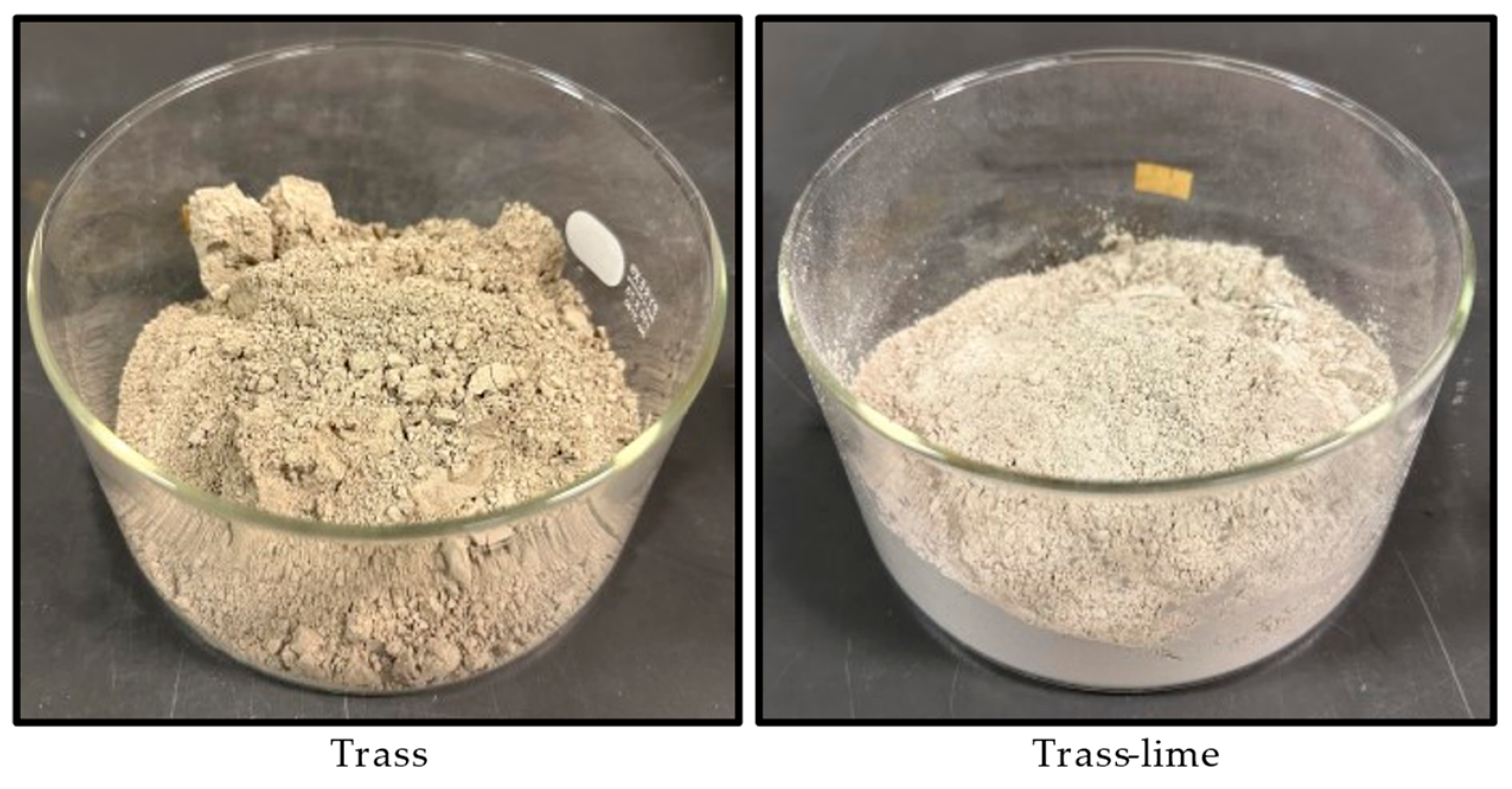
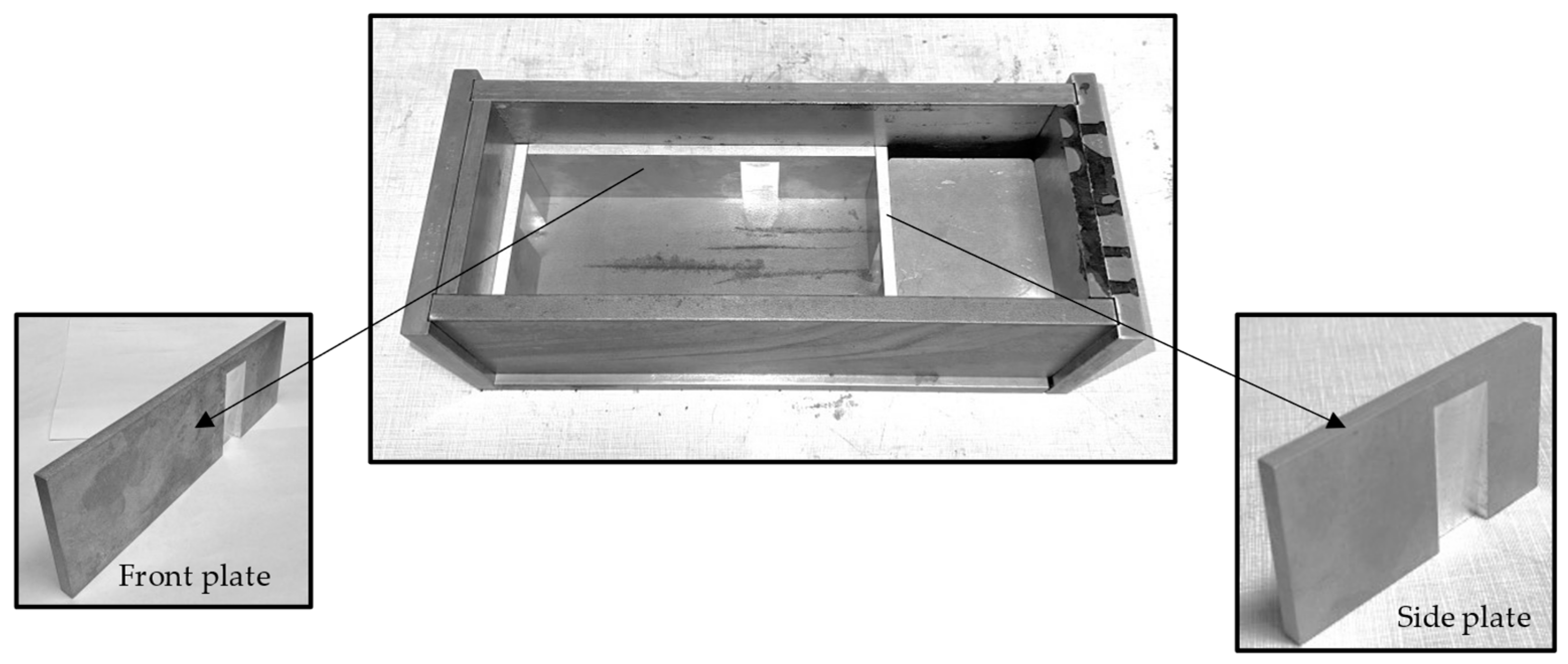
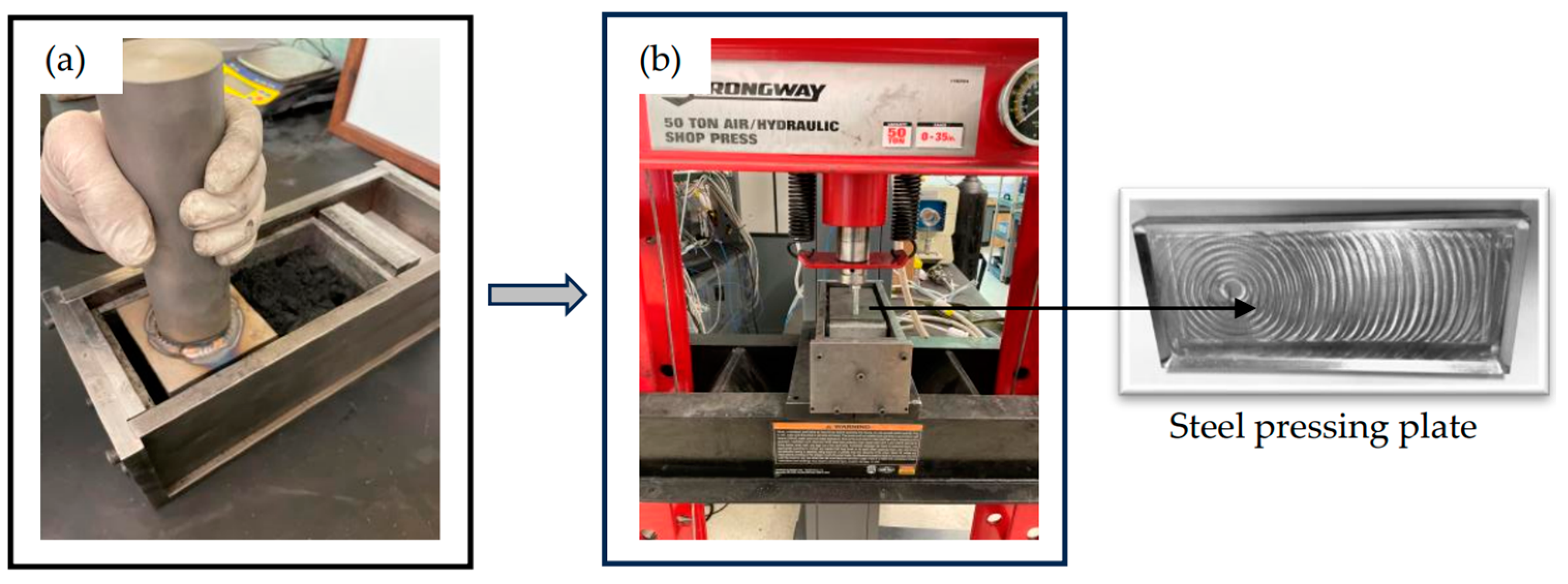
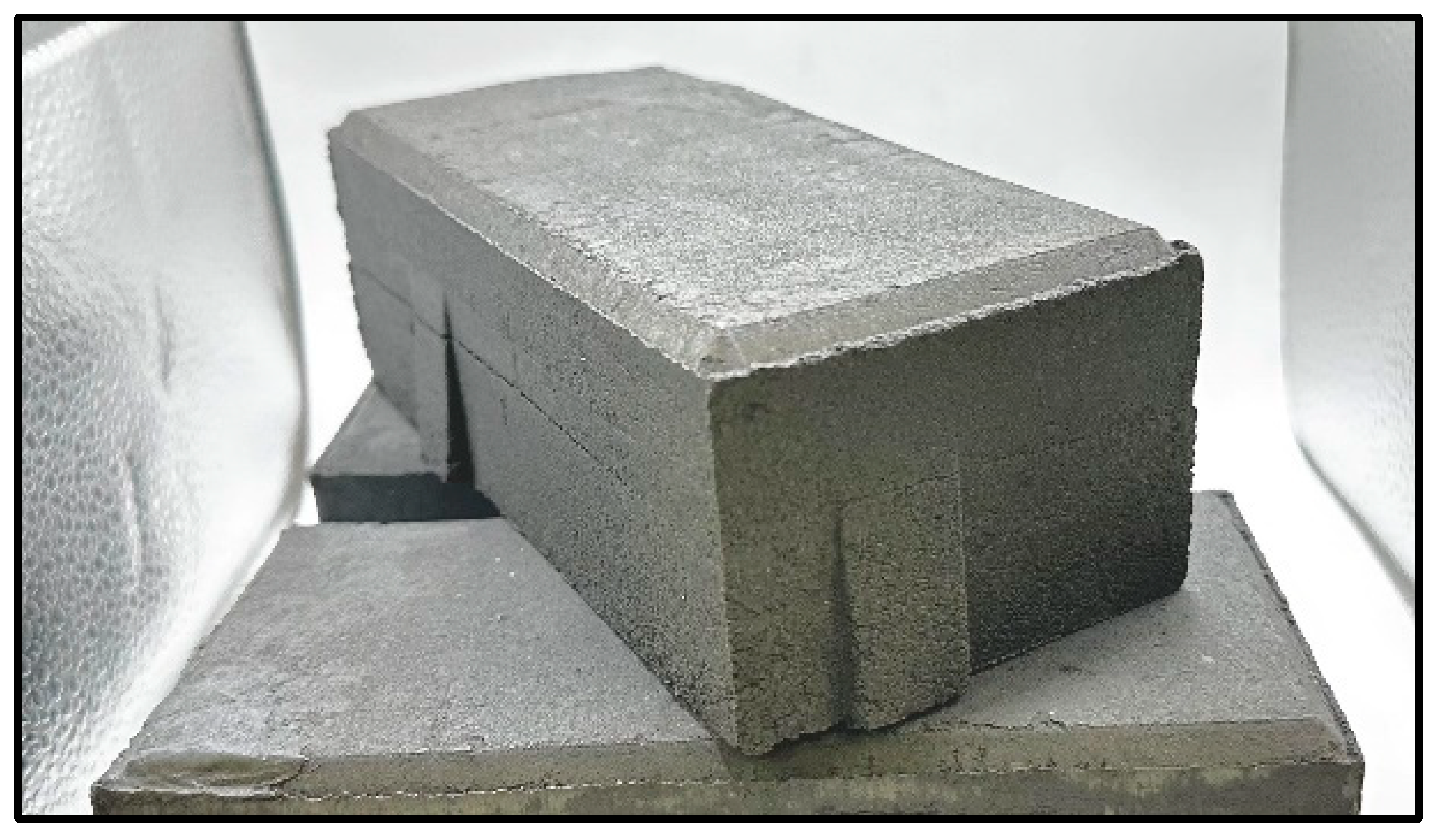
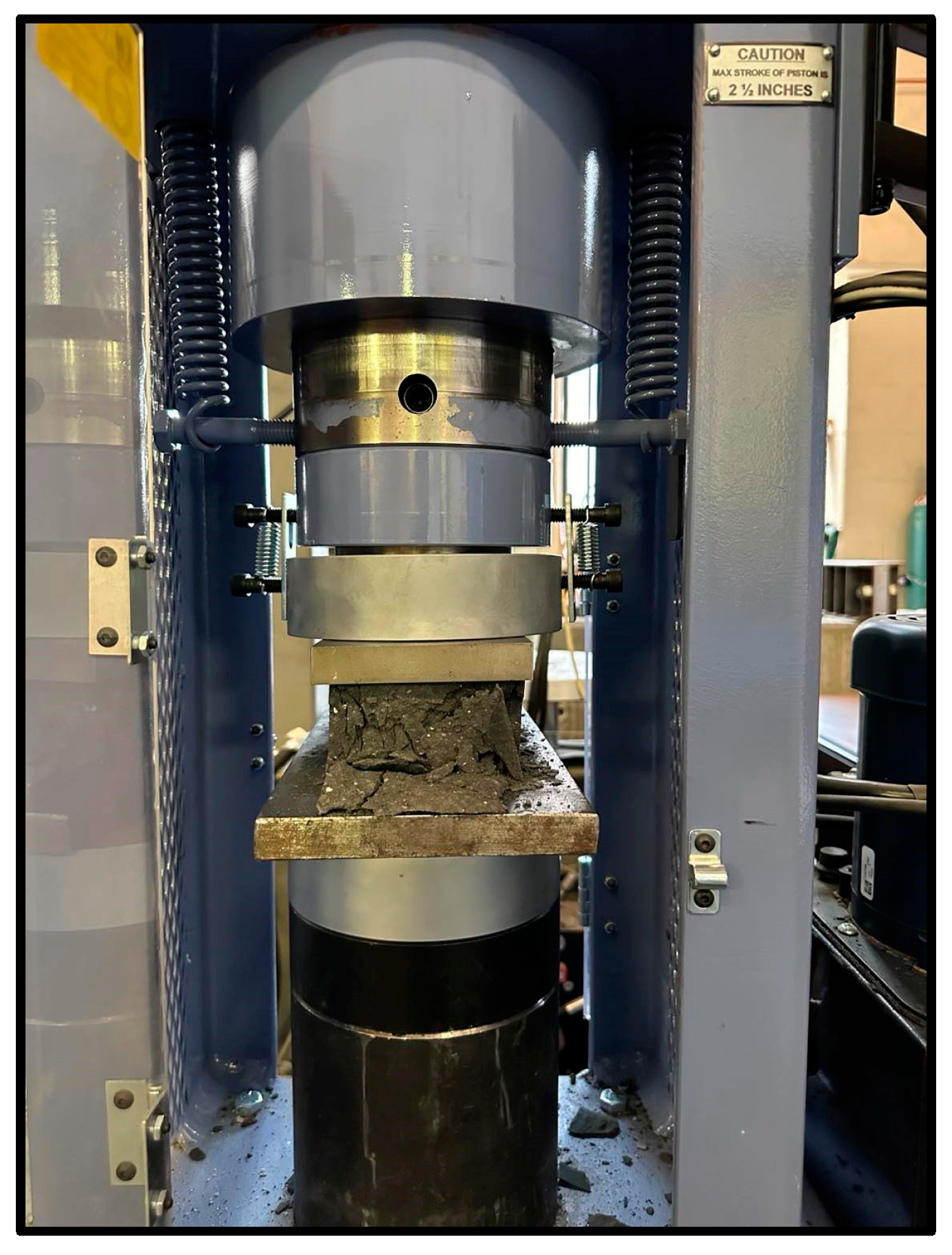

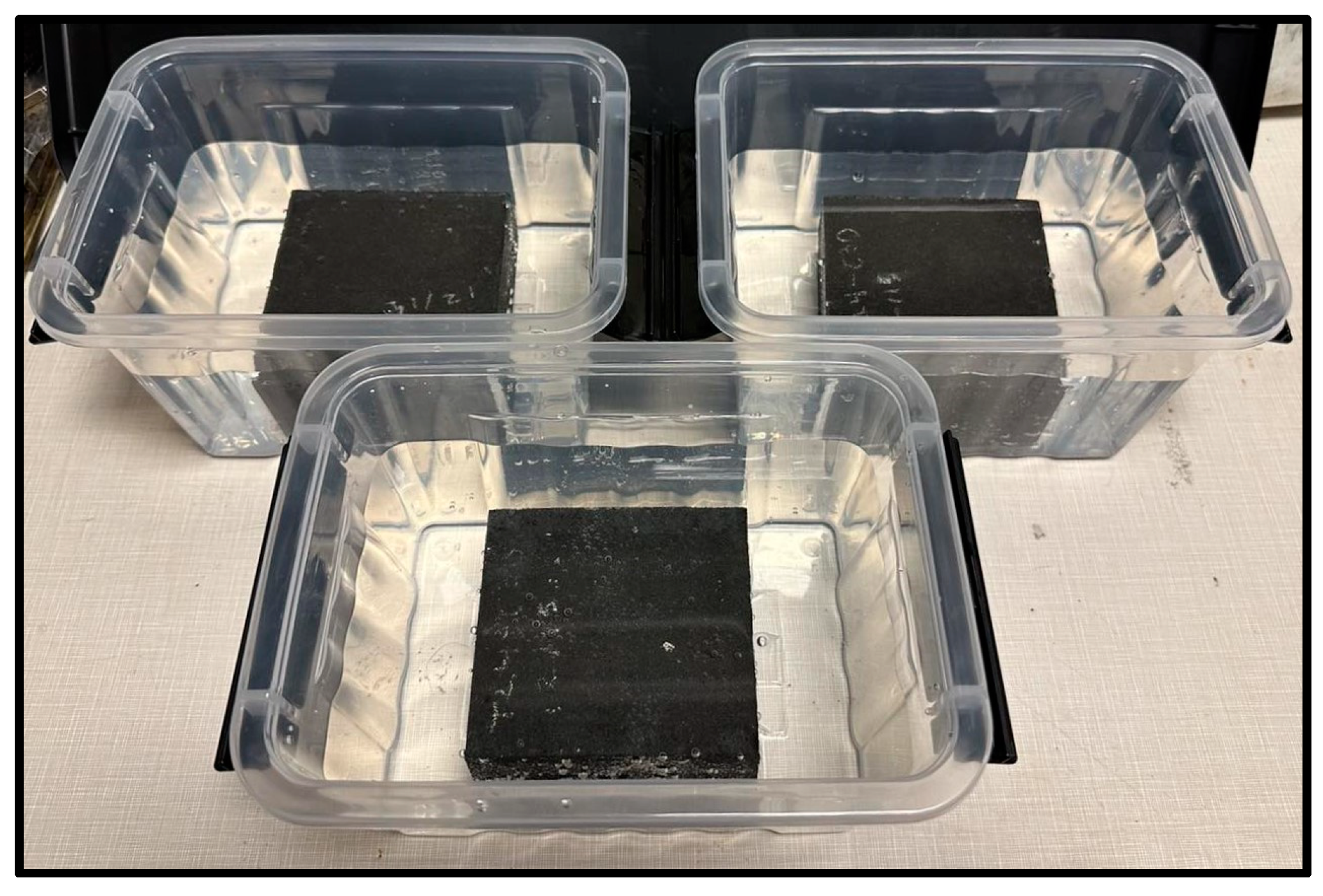
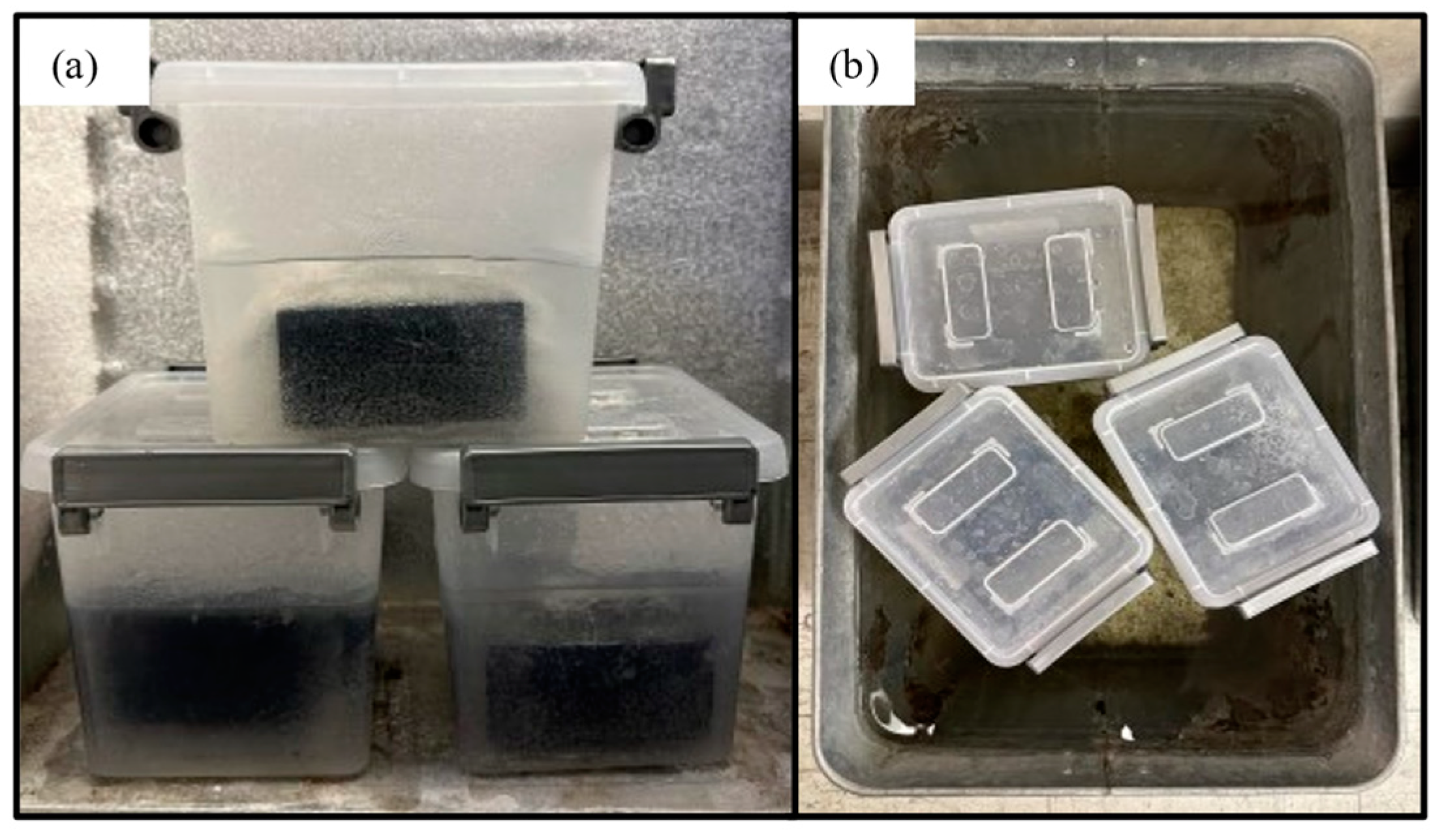

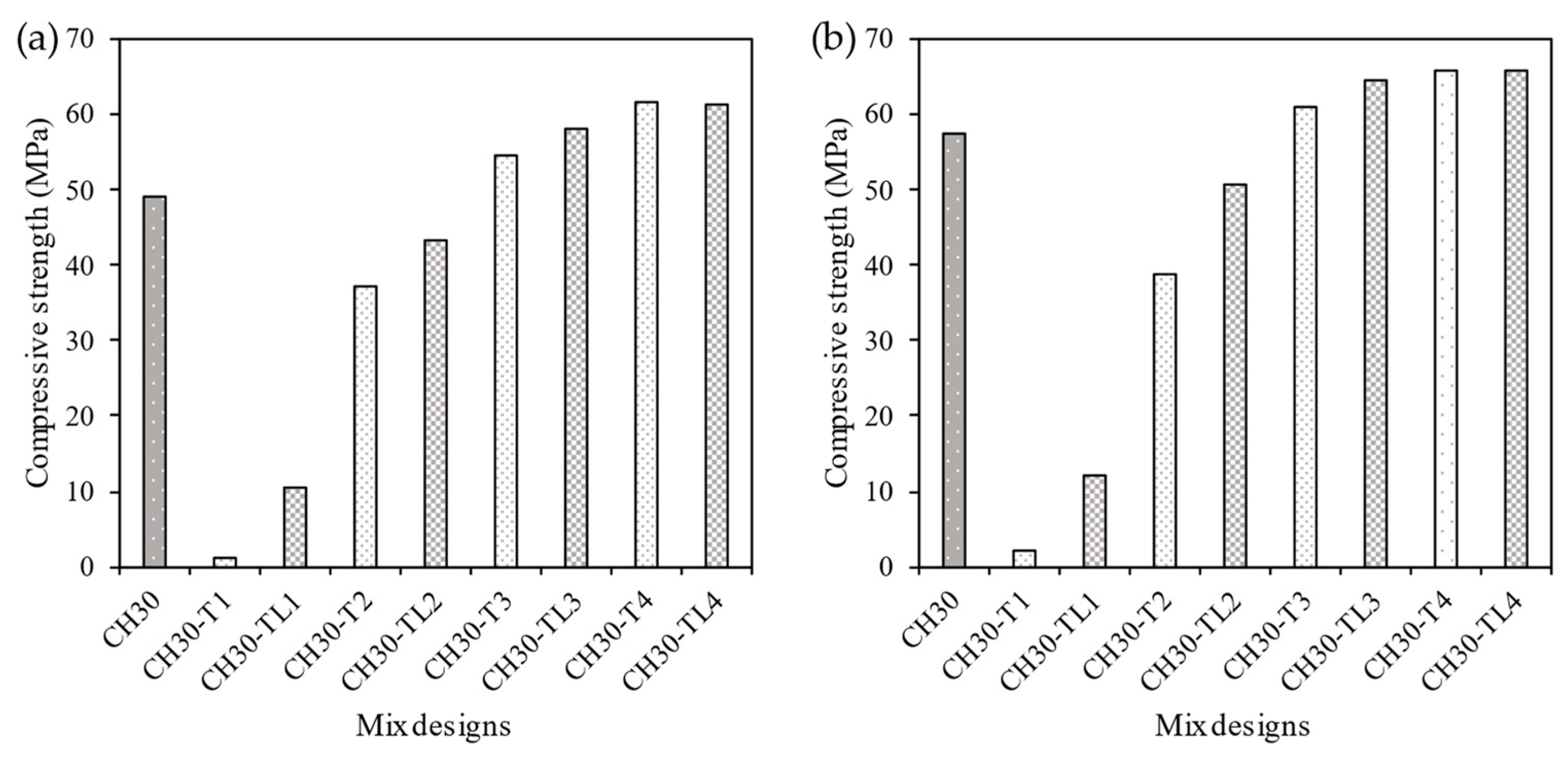




| Sample ID | Char Content (%) | Cement Content (%) | Trass-Lime Content (%) | Trass Content (%) | SF Content (%) | SP Content (%) | w/b Ratio |
|---|---|---|---|---|---|---|---|
| CH30 | 30 | 63.5 | 0 | 0 | 5.3 | 1.2 | 0.37 |
| CH30-T1 | 30 | 0 | 0 | 63.5 | 5.3 | 1.2 | 0.37 |
| CH30-T2 | 30 | 31.8 | 0 | 31.7 | 5.3 | 1.2 | 0.37 |
| CH30-T3 | 30 | 47.6 | 0 | 15.9 | 5.3 | 1.2 | 0.37 |
| CH30-T4 | 30 | 55.6 | 0 | 7.9 | 5.3 | 1.2 | 0.37 |
| CH30-TL1 | 30 | 0 | 63.5 | 0 | 5.3 | 1.2 | 0.37 |
| CH30-TL2 | 30 | 31.8 | 31.7 | 0 | 5.3 | 1.2 | 0.37 |
| CH30-TL3 | 30 | 47.6 | 15.9 | 0 | 5.3 | 1.2 | 0.37 |
| CH30-TL4 | 30 | 55.6 | 7.9 | 0 | 5.3 | 1.2 | 0.37 |
Disclaimer/Publisher’s Note: The statements, opinions and data contained in all publications are solely those of the individual author(s) and contributor(s) and not of MDPI and/or the editor(s). MDPI and/or the editor(s) disclaim responsibility for any injury to people or property resulting from any ideas, methods, instructions or products referred to in the content. |
© 2024 by the authors. Licensee MDPI, Basel, Switzerland. This article is an open access article distributed under the terms and conditions of the Creative Commons Attribution (CC BY) license (https://creativecommons.org/licenses/by/4.0/).
Share and Cite
Pandey, S.P.; Yu, H.; Lau, C.; Ng, K. New and Sustainable Coal Char-Based Paving Blocks for Roadway Applications. Buildings 2024, 14, 1275. https://doi.org/10.3390/buildings14051275
Pandey SP, Yu H, Lau C, Ng K. New and Sustainable Coal Char-Based Paving Blocks for Roadway Applications. Buildings. 2024; 14(5):1275. https://doi.org/10.3390/buildings14051275
Chicago/Turabian StylePandey, Suraj Prasad, Hua Yu, Chooikim Lau, and Kam Ng. 2024. "New and Sustainable Coal Char-Based Paving Blocks for Roadway Applications" Buildings 14, no. 5: 1275. https://doi.org/10.3390/buildings14051275
APA StylePandey, S. P., Yu, H., Lau, C., & Ng, K. (2024). New and Sustainable Coal Char-Based Paving Blocks for Roadway Applications. Buildings, 14(5), 1275. https://doi.org/10.3390/buildings14051275







